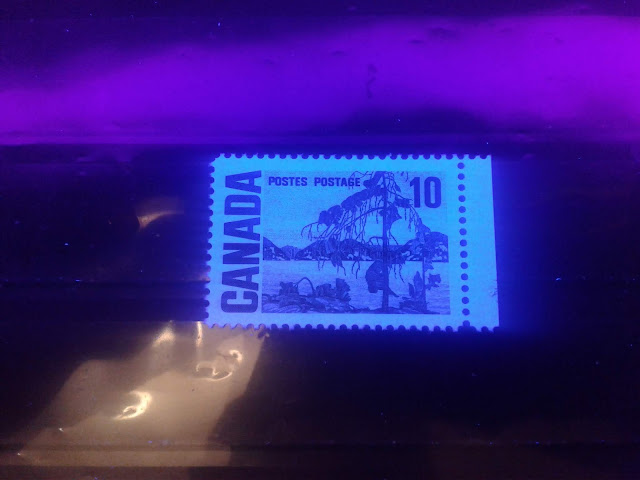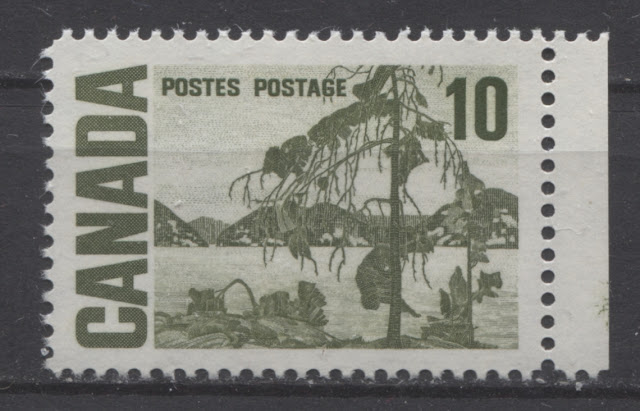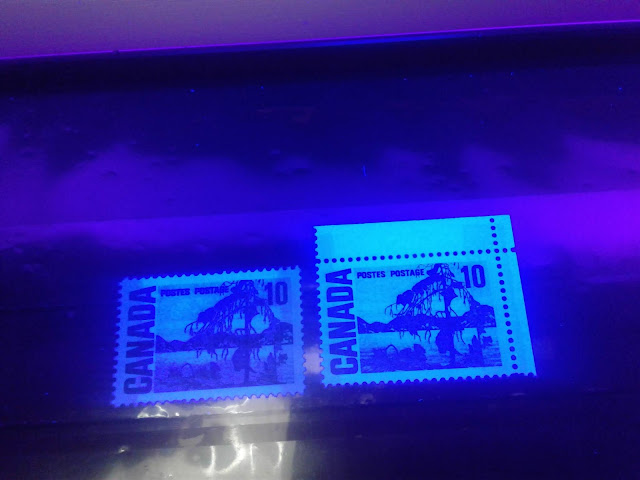This week's post is the second of three posts that will explore the printings of the 10c Jack Pine stamp from this issue. This week, I am looking at the printings that bear the experimental PVA gum that collectors refer to as "spotty white gum". It was a very shiny PVA gum that was at the same time streaky. In many ways it almost looks like a hybrid between the older dextrose gum and the matte PVA gum found on the later printings. It was in use for only a very short time in 1971, as evidenced by the fact that only three commemorative issues from 1971 are found with this type of gum:
It looks pretty bright, but not as bright as some hibrite stamps I have illustrated in other posts. Now, here is how it looks underneath a Winnipeg tagged stamp on paper that would rate a full 12 on the Irwin scale:
As you can see, there is quite a bit of difference in the brightness of these two stamps. If the top stamp is a full 12 on the 0-12 scale, then the bottom stamp would be a 10, which would make it high fluorescent rather than a true hibrite.
As you can see, the bands have the impact of lowering the perceived fluorescence of the paper where they have been applied. In the case of the lightly applied taggant on the right stamp above, the impact is minimal. But in the case of a stamp with heavily applied tagging, like the stamp on the left, the impact is quite marked.
Here is a picture showing the backs of these stamps:
- The Emily Carr stamp, that was issued on February 12.
- The Radio Canada International stamp, that was issued on June 1.
- The Census Centenary stamp, that was also issued on June 1.
Unitrade lists three basic varieties of this stamp with this gum type, which were issued between December 1971 and January 1972. All of them were reportedly printed on hibrite paper, and are as follows:
- Untagged - issued in December 1971.
- Winnipeg tagged - issued in January 1972.
- General tagged - issed in January 1972.
Unfortunately, I do not have an example of the general tagged stamp in stock at the moment, so this post will not be complete until I have an opportunity to examine a group of general tagged stamps. However, my expectation is that the paper, gum and perforation characteristics will be the same for the general tagged stamps, as for the untagged and Winnipeg tagged stamps.
Untagged Stamps - Unitrade #462iii
This is the scarcest regular printing of the 10c, so that I only have a handful of singles, all of which came from the same large block. Therefore my observations have to be interpreted in light of the very limited amount of material I have had available for study. There may be more variation in all of the attributes discussed here than my comments reflect. I will, of course, add more detail as I get an opportunity to study more stamps.
Paper Characteristics Other Than Fluorescence
One of the most striking things about these stamps is that there is a definite sheen to the paper that makes them feel as if a definite surface coating has been applied prior to printing. Under magnification, it becomes apparent that a coating is definitely applied to this paper prior to printing, and this glaze, prevents any loose fibres in the printing surface, and makes the entire printing appear sharper. Against a stark white background, like a stock card, the paper is a very light cream colour, though when compared to the earlier printings on cream paper, it appears a very definite white. The paper bends slightly more easily in the vertical direction than the horizontal direction, which does tend to suggest that it is a vertical wove paper. There is no ribbing visible on either the front, or the back, and when held up to strong back light, there is no mesh pattern visible.
As we shall see when I discuss the tagged stamp, there is also a ribbed version of this paper. I haven't seen it on the untagged stamps, but it is possible that it may exist. If I come across an example, I will certainly update this post to include it.
Paper Fluorescence
Unitrade lists this stamp as only existing on hibrite paper. However, as specialists are well aware, there are high fluorescent and medium fluorescent papers that, when compared to dull and non-fluorescent papers, appear hibrite, but are not quite. Irwin developed a fluorescence scale some years ago for this issue that runs from 0 to 12, with 0 being "dead", 11& 12 being hibrite, and 9 & 10 being high fluorescent. As it turns out, I have found definite variation in the fluorescence of the paper of all these stamps, all of the varieties that I have are all of the tagged stamps, since I only have the one variety of the untagged stamp.
At first, the untagged stamp that I have does appear to be hibrite. Here is how it looks on its own:
It looks pretty bright, but not as bright as some hibrite stamps I have illustrated in other posts. Now, here is how it looks underneath a Winnipeg tagged stamp on paper that would rate a full 12 on the Irwin scale:
As you can see, there is quite a bit of difference in the brightness of these two stamps. If the top stamp is a full 12 on the 0-12 scale, then the bottom stamp would be a 10, which would make it high fluorescent rather than a true hibrite.
Shades
In addition to the paper, the shade of olive green found on these stamps is also striking in the sense that it neither appears overly greyish, yellowish or brownish. On this stamp, the shade is closest to a pure olive green on the Gibbons colour key, though it is deeper, but not deep enough to be a match to the deep olive swatch on the key. Below is a scan of an untagged stamp showing this shade:
As you can see, there is no particular yellowish, greyish or brownish undertone to the colour. You can see the difference more readily if you compare the colour of this stamp to one of the stamps with dextrose gum containing more grey or brown to the colour. Below is a scan that shows this difference more clearly:
The stamp on the left is a dextrose gum printing while the above stamp is shown on the right. At first, they appear to be identical, but just allow your eyes to acclimatize and your gaze to relax a bit. You should begin to see that the colour of the stamp on the left is duller, containing more brown or grey to the colour than the one on the right. It is a slightly brighter olive green.
Gum
The spotty white gum used for the printings of these stamps, like the dextrose gums that came before and the PVA gums that come after, does exhibit some variations if you look closely. I will illustrate these when I discuss the tagged stamps. So, it is possible that the untagged stamps may exist with more than one type of gum. However, the above picture shows the only type of gum I have seen on the untagged stamp. As the picture shows the gum has an overall satin sheen, appears white and has a regular pattern of horizontal streaks in it. If you look at it under magnification though, it becomes apparent that it is actually a colourless gum that is actually somewhat glossy. But the streaks are really uneven areas in the thickness of the gum. At the same time the gum appears quite crackly under magnification. So, it actually is a semi-gloss PVA gum that only appears satin due to the uneven spots and fine cracks in it. The main way in which this gum seems to vary is in the regularity and number of streaks, with some versions of the gum being glossier, with fewer streaks, or with many more, but smaller streaks. I will show these differences in the next section.
Perforations
Given that these stamps were issued in December 1971 and January 1972, as the 11.95 gauge machines were being phased out in favour of the 11.85 machines, one would expect to only find 11.85 as the line perforation. However, I measured the above stamp as perf. 11.95, which does prove that at very least the untagged stamps exist line perf. 11.95. Given that the 11.85 and 11.95 perforating machines were in use concurrently it is very likely that all four perforations can be found: 11.85, 11.85 x 11.95, 11.95 x 11.85 and 11.95.
Winnipeg Tagged Stamps - Unitrade #462pi
Paper Characteristics Other Than Fluorescence
I have found one paper type on these stamps. This paper exhibits nearly all the characteristics that were discussed above or the untagged stamps, i.e. white colour when viewed against a stark white background, vertical wove, and highly coated surface. However, while the untagged stamps are printed on a paper that does not appear to show any mesh pattern when held up to a strong back light, nor does it show any ribbing, the paper that these stamps are printed on seems to exhibit both. Sometimes the ribbing or mesh pattern appears a bit stronger, but to me, these are all the same type of paper.
Paper Fluorescence
As was the case with the untagged stamps, these stamps are reported to exist only on hibrite paper. In terms of the 0-12 brightness scale that I mentioned above I have found three levels of brightness, being 12, 11 and 10. 10 would correspond to the brightest level of high fluorescent, while 11 and 12 are hibrite levels of fluorescence. The picture below shows these three levels of fluorescence:
The upper right stamp is the brightest (12) while the bottom stamp is the least bright (10).
Shades
I have found two shades of colour on these stamps. The first is the same as for the untagged stamps above, being a pure olive green that is just a touch deeper than the olive green swatch on the Gibbons colour key. This shade is shown by the left stamp in the above picture.
The second shade is yellower, and is an almost perfect match to Gibbons's deep yellow green swatch. It is shown on the right. If you relax your gaze and compare the entire design, the difference should be fairly easy to see.
Gum
The majority of the Winnipeg tagged stamps are found with the spotty white gum that was discussed above for the untagged stamps, being that with the regular pattern of blemishes in the gum. However, I have found a second variant of this gum - one in which there are very few of these blemishes and they are strewn in a random fashion over the surface of the gum. The picture below shows these differences:
Perforations
Without exception, all of the stamps I have examined were perf. 11.95, which is not what I would have expected to see, given that it was the 11.85 gauge that superseded the old 11.85 machines by late 1972. So, while all four line perforations should exist on these stamps, I have only seen 11.95.
Tagging
The Winnipeg tagging found on these stamps consists of 8.5 mm bands placed down the vertical perforations of the sheet, as was the case with the previous printings with dextrose gum. The spacing between the tagging bars in the sheet is the same as was found with the dextrose gum printings, with the spacing at the right and left sides of the sheet being narrower than between all other columns.
Whereas the tagging on the dextrose gum stamps appears quite yellowish and visible on the dextrose gum stamps in normal light, there are some printings of this stamp in which the Winnipeg tagging is almost unnoticeable in normal light. Then there are other stamps where the tagging is highly visible as distinct yellow bands. The scan below shows two tagged stamps that exhibit these different intensities of visibility in normal light:
If you look carefully at the left stamp, you can just make out the tagging bars, whereas if you look at the right stamp, you can see them very clearly.
What about the appearance under UV light? On the dextrose gum stamps, the tagging always appears as either bluish white of yellowish white bands that are much brighter than the paper. However, with these stamps, the bands appear darker than the paper and have the effect of dampening the fluorescent effect of the paper. Furthermore, when the tagging has been applied heavily, the bands are visible under UV through the back of the stamp as well as the front - something that wasn't generally the case with the older tagged stamps. The pictures below show two examples of the tagged stamps under UV light: one with the lighter tagging and another with the heavier tagging:
As you can see, the bands have the impact of lowering the perceived fluorescence of the paper where they have been applied. In the case of the lightly applied taggant on the right stamp above, the impact is minimal. But in the case of a stamp with heavily applied tagging, like the stamp on the left, the impact is quite marked.
Here is a picture showing the backs of these stamps:
In both cases you can see the tagging bars, but the bars are much more visible on the right stamp.
General Tagged Stamps - Unitrade #462piiUnfortunately I do not have any stamps available to study. For the moment, based on what I have seen above for the untagged and the Winnipeg tagged stamps, and the fact that these stamps were issued at the same time as the Winnipeg Tagged stamps, I would expect that the general tagged stamps will be found with the same varieties as the Winnipeg Tagged stamps. However, further study will be required to establish this for certain.
Bringing it All Together
All of these stamps, including the untagged stamps are found only on field stock panes, so that there are no plate blocks. Thus, there are only 12 collectible corner blocks for each variety of paper, perf, gum and tagging found. In the case of the untagged stamps, I have only found one shade, one paper type, one gum type and one perforation. So, it is possible that there is only one collectible stamp and 12 corner blocks, though this could easily become 4 collectible stamps and 48 blocks if all four perforations do in fact exist.
In the case of the Winnipeg tagged stamps, I have identified 3 levels of fluorescence, two shades, two types of gum, two tagging intensities and two spacings between the tagging bars. My earlier research suggests that there should be 4 perforations, but I have only found one. So, at very least there are:
3 x 2 x 2 x 2 x 2 = 48 collectible stamps and 48 x 12 = 576 corner blocks.
If there are 4 different line perforations, the number of collectible varieties would be quadruple the above amounts.
I cannot comment on how many varieties there are of the general tagged stamps, but will do so once I have had an opportunity to study them.
This brings me to the end of my examination of the stamps with spotty white gum. Next week I will complete my examination of this value with an exploration of the printings with PVA gum.












